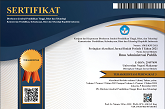Coordination to Reduce Maternal and Infant Mortality in Tasikmalaya District
(1) Department of Public Administration, Faculty of Social and Political Science, Padjadjaran University
(2) Department of Public Administration, Faculty of Social and Political Science, Padjadjaran University
(3) Department of Public Administration, Faculty of Social and Political Science, Padjadjaran University
(*) Corresponding Author
DOI: https://doi.org/10.26858/jiap.v10i1.14592
Abstract
This research explains coordination to reduce maternal and infant mortality rates in Tasikmalaya District. The background of this study is the phenomenon of high maternal and infant mortality rates in West Java including in Tasikmalaya District. The method used in this research is descriptive with a qualitative approach carried out through interviews and observations of the parties involved in the expanding maternal and infant survival in Tasikmalaya District, reinforced by secondary data studies from the results of previous research, as well as data from related institutions. In order for the system in coordination to be effective it is necessary to improve in several aspects related to the system in coordination, in which there are three main dimensions in coordination, the dimensions of the mandate, systems and behaviors.
Keywords
Full Text:
pdfReferences
Akib, H., Guntur, M., & Salam, R. (2016). Civitas Academic Perception of “Blissful Services" for Recipient Postgraduate Program State University of Makassar, Indonesia. International Conference on Public Organization VI (ICONPO VI), 340–350.
Baumgarten, M., Brødsgaard, A., Bunkenborg, G., Foss, N. B., & Nørholm, V. (2020). Nurse and Physician Perceptions of Working With Goal-Directed Therapy in the Perioperative Period. Journal of PeriAnesthesia Nursing, 35(2), 198–205. https://doi.org/https://doi.org/10.1016/j.jopan.2019.09.005
Brieba, D. (2018). State Capacity and Health Outcomes: Comparing Argentina’s and Chile’s Reduction of Infant and Maternal Mortality, 1960–2013. World Development, 101, 37–53. https://doi.org/https://doi.org/10.1016/j.worlddev.2017.08.011
Cho, S., Kim, M. A., & Kwon, S. Il. (2019). Using the photovoice method to understand experiences of people with physical disabilities working in social enterprises. Disability and Health Journal, 12(4), 685–693. https://doi.org/https://doi.org/10.1016/j.dhjo.2019.03.011
Creswell, J. W., & Creswell, J. D. (2017). Research design: Qualitative, quantitative, and mixed methods approaches. Sage publications.
Henderson, A. M. E., & Woodward, A. L. (2011). “Let’s work together”: What do infants understand about collaborative goals? Cognition, 121(1), 12–21. https://doi.org/https://doi.org/10.1016/j.cognition.2011.05.008
Ismail, A., Sulur, A. H., Akib, H., & Salam, R. (2016). Snapshot of Society Social-Economic Welfare based on Human Development Index in Polewali Mandar Regency, Indonesia. International Conference on Public Organization VI (ICONPO VI), 847–858.
Klugman, J., Li, L., Barker, K. M., Parsons, J., & Dale, K. (2019). How are the domains of women’s inclusion, justice, and security associated with maternal and infant mortality across countries? Insights from the Women, Peace, and Security Index. SSM - Population Health, 9, 100486. https://doi.org/https://doi.org/10.1016/j.ssmph.2019.100486
Krogh-Jespersen, S., Henderson, A. M. E., & Woodward, A. L. (2020). Let’s get it together: Infants generate visual predictions based on collaborative goals. Infant Behavior and Development, 59, 101446. https://doi.org/https://doi.org/10.1016/j.infbeh.2020.101446
Nagarajan, S., Paul, V. K., Yadav, N., & Gupta, S. (2015). The National Rural Health Mission in India: its impact on maternal, neonatal, and infant mortality. Seminars in Fetal and Neonatal Medicine, 20(5), 315–320. https://doi.org/https://doi.org/10.1016/j.siny.2015.06.003
Niswaty, R., Juniati, F., Darwis, M., Salam, R., & Arhas, S. H. (2019). The Effectiveness of Leadership Functions Implementation in The Makassar Departement of Manpower. JPBM (Jurnal Pendidikan Bisnis Dan Manajemen), 5(1), 1–10.
Phua, D. Y., Kee, M. Z. L., & Meaney, M. J. (2020). Positive Maternal Mental Health, Parenting, and Child Development. Biological Psychiatry, 87(4), 328–337. https://doi.org/https://doi.org/10.1016/j.biopsych.2019.09.028
Shijagurumayum Acharya, R., Wanvik, A. K., & Stensdotter, A. K. (2015). Community placement for students is an important resource for the development of the primary level health sector in Nepal. Physiotherapy, 101, e1385–e1386. https://doi.org/https://doi.org/10.1016/j.physio.2015.03.1330
Tonmoy, F. N., Cooke, S. M., Armstrong, F., & Rissik, D. (2020). From science to policy: Development of a climate change adaptation plan for the health and wellbeing sector in Queensland, Australia. Environmental Science & Policy, 108, 1–13. https://doi.org/https://doi.org/10.1016/j.envsci.2020.03.005
Wader, N., Darwis, M., Salam, R., & Baharuddin, A. (2020). Application of the Transformational Leadership Style at the BKKBN office in South Sulawesi Province. PINISI Discretion Review, 1(1), 7–12.
Wildana, A., & Awaru, A. O. T. (2018). Perilaku Akademik Aktivis (Studi Kasus Pada Mahasiswa Fis UNM Yang Aktif di Organisasi Daerah). JURNAL SOSIALISASI, 1–6.
Article Metrics
Abstract view : 259 times | pdf view : 36 timesRefbacks
- There are currently no refbacks.
Copyright (c) 2020 Jiwa Riwayanti, Heru Nurasa, Erlis Karnesih

This work is licensed under a Creative Commons Attribution 4.0 International License.
Diterbitkan oleh:
Program Studi Ilmu Administrasi Publik
Program Pascasarjana Universitas Negeri Makassar
JIAP Index By:

This work is licensed under a Creative Commons Attribution 4.0 International License.









